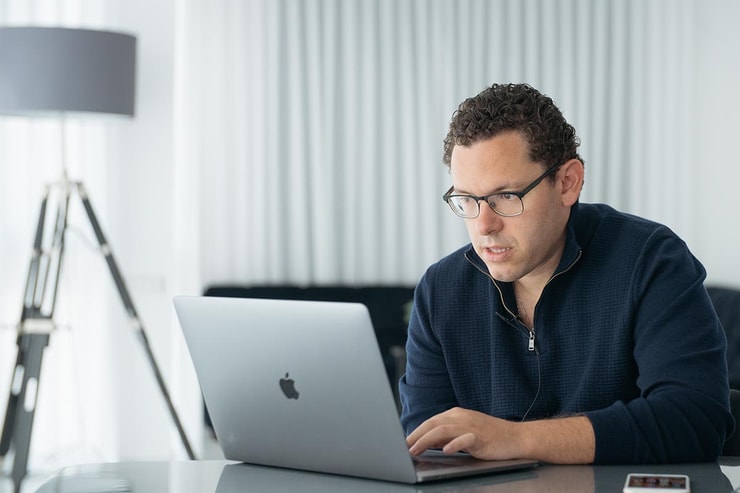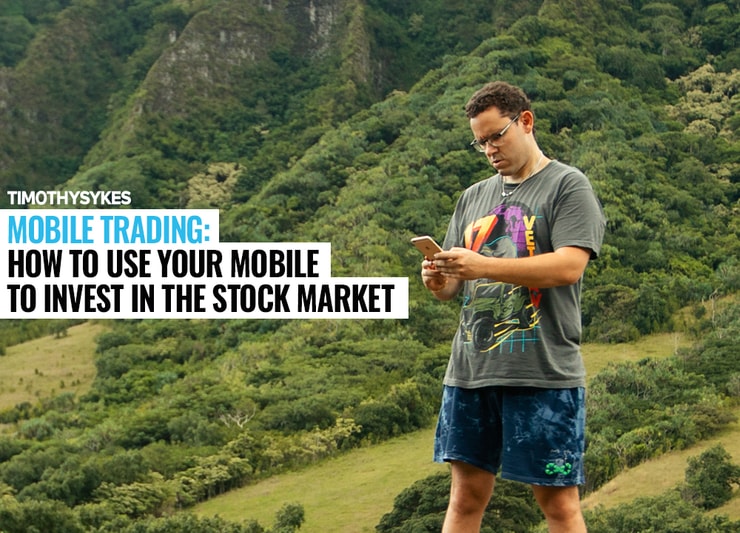Sometimes I don’t feel like lugging around a laptop, and that’s why I think mobile trading is awesome. Here, I’ll dig into the benefits of mobile trading and how to choose the best app to suit your trading preferences and lifestyle.
Who loves being stuck behind a computer all day? Not me. I like to take advantage of the flexibility of day trading by constantly traveling and doing my work from wherever I am.
But sometimes I don’t feel like lugging around a laptop, and that’s why I think mobile trading is awesome.
With mobile trading, you can download apps that are just like online dashboards, and execute trades while you’re on the go. That means no more panicking when you have to step away from your computer for a few hours or when you’re traveling.
Here, I’ll dig into the benefits of mobile trading and how to choose the best apps to suit your trading preferences and lifestyle.
Table of Contents
What Is Mobile Trading?
Mobile trading simply means trading that you do from a smartphone (or a tablet).
The “mobile” in mobile trading is both literal and figurative: the trading is, in fact, conducted on your mobile phone, and it can be done on the go.
With mobile trading, you don’t have to be stuck in an office, chained to your computer. You don’t even have to have your laptop, so you don’t necessarily have to chase WiFi signals at coffee shops or a shared work space.
Mobile trading allows you to manage your investments from anywhere that you have service. This means that whether you’re on vacation or just out running errands, you have access to your accounts and trading.
To clarify, mobile trading isn’t just a way of checking your account balances or the price action of stocks. You can access a platform for trading stocks on your phone, executing instantly no matter where in the world you are.
How to Use Your Mobile to Invest in the Stock Market

2025 Millionaire Media, LLCGetting set up for mobile trading is pretty easy. You just need to download an app, enter your information, and get trading. Of course, the setup will differ slightly depending on the app, but it’s generally pretty straightforward.
Perhaps more important than the logistics of your mobile trading setup, though, is getting yourself in the right mindset for trading on your phone.
Just because it’s on the same tiny screen you use to play Candy Crush doesn’t mean the trading should be taken any less seriously. Here are some tips for how to mentally prepare:
Define your goals. It’s incredibly important to have clearly defined goals. You can read more about why in my post on goal setting theory, but suffice it to say that goals are the best way to stay motivated and get clarity on how to actually achieve your goals over time by breaking them into manageable milestones.
However, goals can do more than just provide motivation. They can also help you decide the best approach for trading, regardless of whether you’re on a laptop, a desktop, or your phone.
One of the biggest ways is that it can help you determine the time horizon. In trading, the time horizon refers to the time frame in which you’d like to realize a financial goal.
For instance, if you’re saving for retirement, you might pursue position trading, because you have time to research and find stocks that will deliver over time.
However, if you wanted to save up for a down payment on a house within the next two years, you might want to take a more aggressive and risk-forward approach like day trading low-priced stocks.
There’s no right or wrong goal as a trader, so don’t edit yourself. But do be honest about your goals so that you can plot the best approach.
Research different apps. Mobile trading apps aren’t one size fits all. Just like any other program or service, different people look for different things to suit their needs.
Don’t just filter on how many stars each one has and choose the app with the most likes. Don’t trust the crowd or just listen to what someone else suggests: Do your own research.
With your specific goals in mind, start to read about the features of the different apps available. Look at a variety of different factors to determine not just how “good” the app is but whether or not it is in line with your goals and suits your trading style.
For instance, if a low or no fee app is important to you, be sure to read the fine print. There could be hidden fees or an account minimum, resulting in unforeseen costs.
On the other hand, if a well established and user-friendly experience is very important to you, choosing a better-known app like TD Ameritrade might be worth a slightly higher transaction fee.
Before settling on a mobile trading app, be sure to read reviews, look at the fee schedule, and consider what you want from your app before committing.
Figure out your account size. How much do you need to start trading? That’s one of the most common questions I get. Unfortunately, it’s not a cut-and-dry answer.
Different traders start with different amounts. For short selling, the figure I will usually say is that you’ll need to start with $2,000. But there are exceptions. For instance, one of my top students, Tim Grittani, started with just about $1,500.**
Others start with $10,000, and some penny stock traders will start with practically nothing.
Starting with a small account isn’t a bad thing. Actually, it can be a very good thing, because if you don’t have much money, you’ll have to focus on studying, which is probably more important when you’re just starting out, anyway.
When you start small, you can build your account incrementally and over time, and learn valuable lessons about how to trade effectively while you do it. This means that as your earnings scale up, so can your positions.
In terms of mobile trading, your account size may matter because while some platforms may have no minimum, others do. Make sure you’re not slapped with unexpected fees!
Learn the rules. It’s tempting to want to dive right in and get trading once you’re set up on a mobile app. But remember — this is real trading! It’s your actual hard earned cash at work.
Unless it’s your deepest desire to crash and burn your account fast, then take the time to learn the basics of trading before getting started.
Take the time to learn some trading skills before you start making mobile trades. Without a foundation of education, you’re really just gambling. And the consequences can be big, no matter how little the screen you’re using to trade.
Since you can never know what the market will do, so there will always be a certain amount of risk. But when you come at your trades form a place of planning and education, you can rest assured that you are doing all that you can to mitigate that inherent risk.
Top Brokers to Use For Mobile Trading: My Full Review

2025 Millionaire Media, LLCCurious about the top brokers for mobile trading? Here are some of my thoughts on the most prominent platforms.
Mobile Trading With TD Ameritrade
As one of the biggest brokerages in the country, TD Ameritrade has not one, but a few different apps dedicated to trading.
The most basic app is TD Ameritrade Mobile. On this app, you can monitor your positions and execute trades. It’s pretty similar to the TD Ameritrade desktop site.
Then there’s the slightly fancier TD Ameritrade Mobile Trader app. This one lets you customize various settings to create a dashboard with all of the information you want to see.
You can also get access to research modules, transfer funds, and get market alerts and some good learning materials. It has plenty of technical analysis and charting information to help you decide on trades on the go.
There’s also TD Ameritrade’s Thinkorswim. This is the trading app companion to the popular trading platform that goes by the same name.
In terms of trading, Thinkorswim is pretty similar in its functions to the TD Ameritrade Mobile Trader app. However, the design is a little different and the charting is arguably a bit more advanced and in depth.
On Thinkorswim, you can trade stocks, options and complex options, ETFs, futures, and forex. There are also chat rooms and daily programming from TD Ameritrade professionals.
There are also some nice touches like the ability to stream live CNBC, access events with an interactive market calendar, and you can link your desktop and device to synch the symbol being viewed.
Benefits of Trading Mobile With TD Ameritrade
I use several trading platforms, and TD Ameritrade is one of my favorite broker apps. As a bigger bank, it’s able to offer a much nicer interface and features that are second to none.
Of course, it’s not without its detractions as well. Which leads to the next topic …
Pros and Cons of Using TD Ameritrade
What are some of the pros and cons of using TD Ameritrade? Here are some important ones to consider:
Pros:
User-friendly. The mobile trading program on TD Ameritrade is easy extremely intuitive, and you’ll be able to master it in minutes.
Quick trades. No timing out or long loading here. This platform is reliable and quick, meaning you can make your trade instantly.
Sync your screens. The apps can be linked to the desktop application. You can use your phone as a second screen, or even to act as a remote control on your desktop.
Recognizable. If you use the TD Ameritrade website, the mobile app will look familiar. The information is presented similarly, so you won’t have to re-learn where things are.
Nifty tools. There’s a customizable sidebar, real-time quotes, and a feature that lets you make trades from any page rather than having to do it from a static page.
Access to all your documents. The app lets you see your account statements, tax documents, and any messages. This can be handy.
All access. On some apps, you need to meet certain criteria to access certain features. On TD Ameritrade, you don’t have to meet any of these, you get the same access no matter what your account size.
24/7 customer service. Since it’s a bigger organization, the customer service is also bigger and better. It’s professional, fast to respond, and can be contacted 24 hours a day.
No minimum. There’s no minimum amount required to open your account with TD Ameritrade, so even if you only had $5 you could start an account. But it’s probably better to start with more.
Cons:
Too many apps? Yes, TD Ameritrade has three associated apps. Can this get confusing? You bet. It can be hard to know the differences between each. You’ll need to do some research and might even need to speak to customer service to determine which one is best for you.
High trade fees. At the time of this writing, the fees for trades were $6.95 on TD Ameritrade. This is on the high end of online broker fees. The fees don’t stop there: For a no-load mutual fund, for instance, the fees could be close to $50.
Manage Everything With TD Ameritrade Mobile App
One of the big advantages of the TD Ameritrade mobile app is that it has range.
Whether you’re a technical trader or a derivatives trader, and whether you’re trading stocks, futures, on the Forex exchange, or options, this platform can handle it.
The platform was built with an active trader and investor in mind. It’s pretty loaded in terms of its features and allows you to effectively manage your investments on the go.
With the TD Ameritrade apps in hand, you can feel totally comfortable going away for a few days or being away from your computer and feeling assured that you can handle whatever pressing trading work you might need to do while on the go.
More Breaking News
- Pharma Boom: Verona Pharma’s Latest Surge
- Grayscale Bitcoin Trust Rebalances Funds: Market Reacts
- VEON’s Digital Leap: A New Era
Free Mobile Trading Apps

2025 Millionaire Media, LLCLooking for fewer fees? Consider Robinhood.
Mobile Trading With Robinhood — Free of Charges!
Robinhood actually started as an app before it launched a website, so the accent is on a mobile format with this company.
One of the big draws of Robinhood is that it offers free stock trades. That’s right: When you execute a trade, they don’t charge a transaction fee.
However, be sure to read the small print, because no transaction fee doesn’t mean everything is free. As the Robinhood website says, “Robinhood does not charge fees to open or maintain an account, transfer funds, or buy stock. However, there are fees charged by the U.S. Securities & Exchange Commission and FINRA on all sell orders.”
So, depending on what types of transactions you’re conducting on the site, there may be fees associated with it.
If you upgrade to the Robinhood Gold account, which has more features, there’s a monthly fee. Upgrading gives you access to margin trading and extended-hours trading, among other things.
Best Stock Trading App for Beginners
Looking for an easy place to get started? These apps are ideal for beginners.
Acorns
This is a great app for new traders. First off, you can link it to your bank account in a pretty unique way.
You can set up a program where it rounds up your purchases to the next dollar, and these amounts are transferred into your Acorns account for investing. You can also add money manually. So it’s an easy passive way to build up trading capital.
Once you’ve amassed some cash in your Acorns account, it acts as a kind of robo-advisor for you, helping you build a portfolio of investments based on your goals and risk preference, which are ascertained through a questionnaire you’ll fill out when making your account.
While I love doing my own research and making my own choices for investments, this can be a great way for totally new traders to get their feet wet and to see how various investments react in the market.
It also has built-in diversity, so it can help you decide which direction you’d like to pursue as a trader.
Metatrader App
Metatrader is another app that’s ideal for newbies and one of the premier apps for Forex trading.
One of the biggest advantages is that per the app description, you can actually choose from “hundreds of brokers and thousands of servers” to create a trading platform that is just right for you.
From this app, you can trade, analyze the market, and use technical indicators.
You can get real-time quotes, trade from charts, execute all types of trades, and maintain a log of your trading history. It also has a number of customizable features, so that you can keep track of the information you want to see.
The technical analysis tools are pretty advanced, featuring 30 technical indicators, analytical objects, and several types of charts.
Mobile Trading Advantages
How can mobile trading help you become a more effective trader? In a few ways.
For one, every trader knows how stressful it can be to have to go away from your computer during trading hours. The anxiety can be staggering. Having a mobile app close at hand can help you make quick entries and exits so that you can manage your account from the road.
This is particularly great if you’re traveling or on vacation. Since I travel so much, mobile trading has saved my ass(ets) many a time.
Your mobile trading app will also give you alerts, so you don’t have to be constantly checking. Your device will let you know when something needs your attention.
Tips Important Factors for Mobile Trading Success

2025 Millionaire Media, LLCIf you want to maximize your success with mobile trading, consider these tips.
Get Used to Technical and Fundamental Indicators
In my Trading Challenge, I put a lot of emphasis on studying and making use of indicators and analysis.
There are a ton of technical analysis tools and fundamental indicators out there, and it can be easy to become overwhelmed by them. However, one of the benefits of mobile trading apps is that they make it easy to sort through them.
As you keep trading, keep track of the indicators and analysis that is most informative to your trades in your trading journal.
This will help you zero in on the information you want to find when pursuing stocks in the future, and will help you execute your mobile trades with more confidence. This guest post from one of my trading students offers some great insight as to a few indicators worth using.
Keep an Eye on Key Patterns
Learning to read stock charts and how to identify patterns is extremely important for traders. In fact, many of my top trading challenge students** have built their accounts exponentially by following reliable patterns.
I focus on teaching my students patterns and strategies such as dip buying and shorting supernovas, as well as what I call my “gimme” pattern of buying low-priced stock breakouts on volume.
Yes, it will take time to develop your skills, but once you do, you’ll be able to forge your own path as a trader. The idea is that you want to learn how to identify potential trades ahead of the pack by getting very good at seeing patterns.
Since history repeats itself pretty closely, once you’ve learned how to read patterns, you can apply it to mobile or desktop trading and use these techniques to your advantage across multiple platforms.
Develop a Trading Strategy
Finding long-term success as a mobile trader means that you have to have an edge. This means that you’ve got to have a little more strategy than just “buy and sell.” You really need to think about what’s working and why, and to be able to refine your techniques over time.
Identifying patterns and researching stocks thoroughly is part of it. But you also need to keep track of your trades and techniques in a trading journal.
As you see your own trading data amass over time, you’ll be able to see what’s working for you, and what’s not. This allows you to develop a unique trading strategy for yourself.
That means that you’ll be able to refine your strategy so that you can choose trades that have your desired level of risk and reward, and that work with your strengths.
Knowledge is Key
What you need to remember in mobile trading is that it’s less about the app and more about your level of knowledge.
Yes, a flashy app with all sorts of features is fun and can make trading easy. However, to really find success on a mobile app, you need to focus on putting capital in the most important “account” there is: your education.
Knowledge is key to finding success as a trader, regardless of your account size, trading style, or what platform you’re using. The more knowledge you have, the better decisions you’ll make.
Taking trading classes can help you whiz past the learning curve so that you can develop a strong foundational knowledge that will inform and assist you in making calculated risks with your trades.
Armed with trading knowledge, you’ll likely have greater success on any app or platform!
Trading Challenge
My Trading Challenge is one of the most comprehensive trading resources for aspiring traders. At this point, my video library of lessons is pretty epic, and includes all sorts of topics relevant to day traders, from basics to pattern recognition to advanced trading techniques.
But it’s not just video lessons. My Challenge offers a real-time education too, as I am right there trading alongside my students.
I publicly share every trade on Profit.ly and constantly share my thoughts, advice, and analysis. My students have the opportunity to learn by doing, which is really how you’ll gain insight to how the market works.
The Bottom Line
Mobile trading apps can help you take your trading career anywhere. You can literally have the market at your fingertips, regardless of whether you’re in an office, on the bus, or in line at the DMV.
However, just because mobile apps make trading accessible, it doesn’t mean it’s any easier. So yes, take advantage of the technology, but don’t forget the importance of technical analysis. You still have to put in the work and do your research to help mitigate risk and make intelligent trades.
Do you use mobile trading apps?












Leave a reply